by Musah Aziba Issah, George Owusu, Rosina Sheburah Essien and Kofi Kekeli Amedzro
Over the last decade, many African cities have witnessed growing infrastructure investments by global development actors. In Ghana, Accra has become an important destination for such infrastructure investments due to the city's connection with the global economy and its strategic position as the national capital (Owusu and Yankson, 2017). This raises important conceptual and empirical questions about the nature of the actors driving the urbanisation process, especially why certain projects are taking place and what that means for contemporary urban governance, namely, who is shaping urban development. How urban infrastructures are financed and governed is integral to explaining the socially and spatially uneven infrastructural provision and its urban development ramifications.
Figure 1: President Nana Akufo-Addo signs $2 billion Sinohydro deal in China
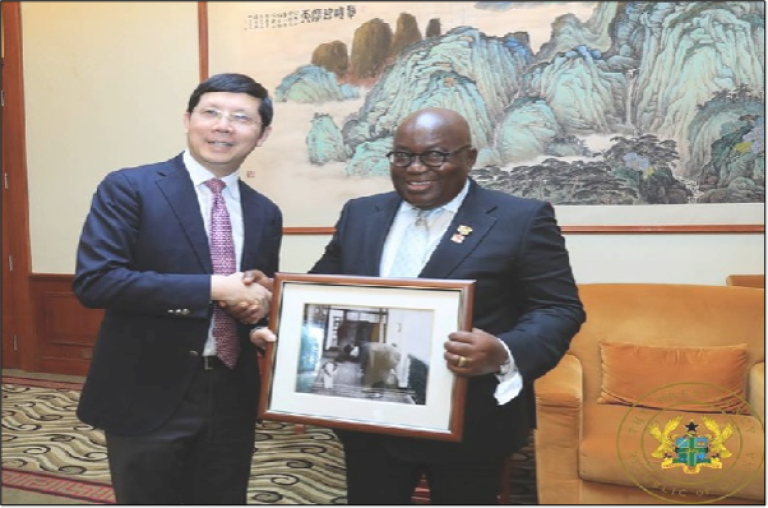
Source: Prime News Ghana, 2018
To answer these questions, we reviewed the media coverage of infrastructure projects in the Greater Accra Metropolitan Area (GAMA) as published in the Daily Graphic (a state-owned newspaper) and Daily Guide (a privately-owned newspaper), from 2011-2021, for our analysis. These two newspapers have a widespread readership across Ghana and are published daily except Sunday. The Daily Graphic was established in 1950 and Daily Guide in 1984, and both are considered the most widely circulated newspapers in Ghana (Agyei-Mensah et al., 2022; Elloit, 2018). In this blog, we explore two issues. Firstly, we explore variations in reporting over time. Kenis and Barratt (2021) explain that the media oftentimes have editorial preferences that influence their coverage and because of that they choose to report on some aspects while downplaying and/or ignoring other aspects. Nonetheless, the media continues to play an important role in educating the public about government projects and infrastructure investment, thereby shaping the infrastructure discourse in Ghana. Secondly, we explore the overall reporting on infrastructure types and different funders of investment, to provide insight into the nature of urban infrastructure financing and urban governance in GAMA.
- Variations in infrastructure reporting over time
Our analysis revealed that the Daily Graphic published relatively more stories (76) on urban infrastructure projects in GAMA than the Daily Guide (60) for the period, 2011-2021. This might be because the Daily Graphic, as a state-owned newspaper, has an advantage with access to information, official announcements, and a degree of financial support, which helps it maintain a strong presence in the media landscape. Government interests in publicising achievements in infrastructure investment play a role. In relation to this newspaper, the coverage of these infrastructure projects decreased strongly from 2011 to 2016, then increased from 2017 to 2019 (see Fig. 2). The Daily Guide also dipped in 2015, and again in 2021. For infrastructure projects overall, the largest number of media stories was reported in 2011, while the fewest stories were reported in 2016. The highest number of stories Daily Graphic published annually on infrastructure projects was in 2011 and Daily Guide was in 2019.
Figure 2: Urban Infrastructure Projects publications per year from 2011 to 2021
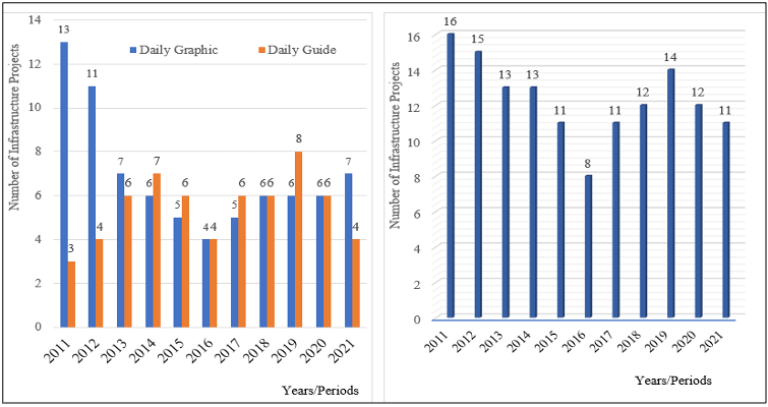
Source: Derived from Daily Graphic and Daily Guide, 2011-2021
One explanation for this variation concerns the role of electoral politics. This review discovered that the media coverage of infrastructure projects in GAMA intensified during years preceding national elections and actual election years – thus, in 2011/2012 and 2019/2020 (see Fig. 2). The exception, however, occurred in 2015/2016 which was also an election year. The media reporting of infrastructure projects tends to be high during electioneering years because the sod-cutting and commissioning of new projects are generally seen as part of the ruling parties' strategy to improve their public image and retain political power. For instance, while inaugurating the Pokuase Interchange, President Nana Akuffo Addo lightheartedly teased the opposition with a comment, saying:
"Indeed, two hundred and eighty-nine million United States dollars (US$289 million) has been used by the Akufo-Addo government to construct three (3) interchanges, that is at Pokuase, Obetsebi-Lamptey, and Tamale, as opposed to two hundred and sixty million dollars (US$260 million) being used, by the Mahama government, to construct just the Kwame Nkrumah Interchange. These are further examples of the fact that we, in the New Patriotic Party, are good protectors of the public purse." (Pulse News, 9thJuly, 2021).
Figure 3: Vice President, Dr Bawumia cut sod for the construction of a $200 million Inland Port project
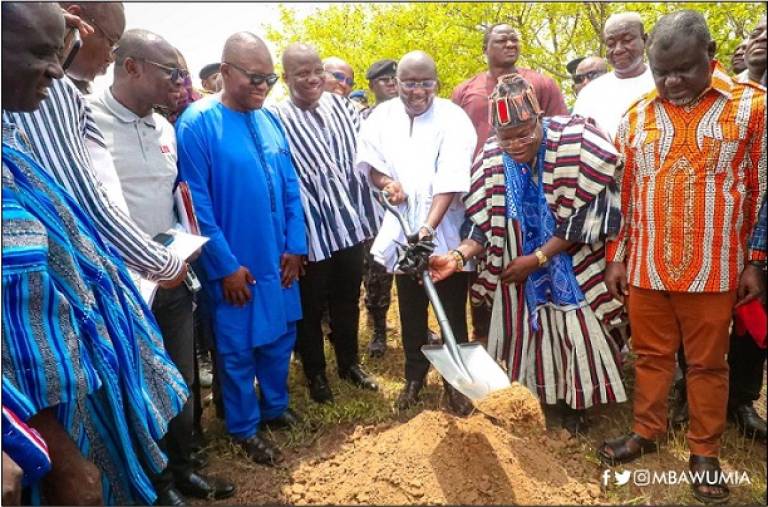
Source: Ghanaian Times, 2022
The exceptional case for 2015/2016 electioneering years could also mean that these reportages are sometimes political because the media could selectively report issues that drive traffic to their pages and/or are influenced by political alliances. This is not surprising as Kenis and Barratt (2021) explain that the media oftentimes have editorial preferences that influence their coverage and because of that they choose to report on some aspects while downplaying and/or ignoring other aspects.
- Nature of urban infrastructure development reported from 2011-2021
The two media outlets reported on a variety of urban infrastructure developments such as roads, interchanges, railways, drainage, and storm drains among others. Out of these, roads and flyovers/interchanges received the most media attention. The focus on road infrastructure in GAMA is not surprising as it has received the government's attention more than any sector since the 1990s. In addition, the ruling government as part of its electioneering campaign designated 2020 as the “Year of Roads” and negotiated a contract with the Sinohydro Corporation Limitedamong other actors to build important infrastructure projects (including roads) across Ghana. For instance, the Pokuase Interchange, which is a four-level stack interchange situated at Pokuase Junction, is the largest interchange in West Africa (see Figure 4). It was originally a three-tier as proposed by the former President, John Dramani Mahama, in 2016, but was modified to a four-tier interchange by the Nana Akufo-Addo administration. The construction began in 2018 and was commissioned for vehicular use in 2021 by President Akufo Addo. The cost of constructing the interchange is estimated at 94.8 million dollars and was jointly funded by the African Development Bank and the Government of Ghana.
Figure 4: An Aerial View of the 4-Tier Pokuase Interchange
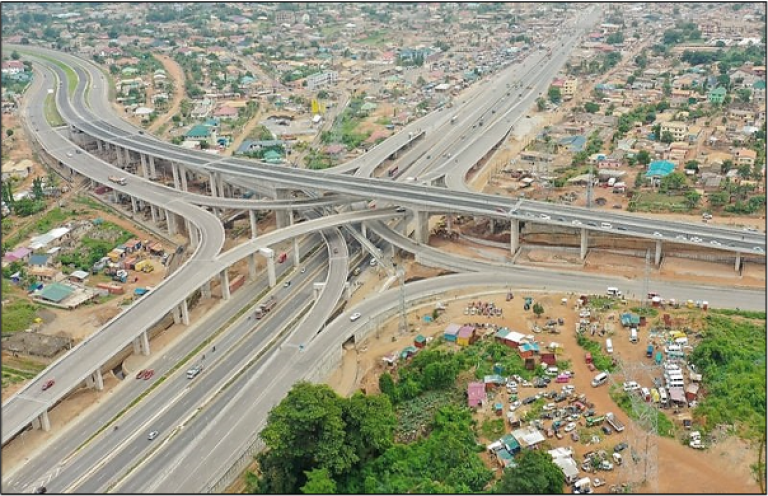
Source: Government of Ghana, 2018/BBC News, 2021
Drainage and sanitation related infrastructure projects were also widely covered by the media. These included landfills, waste treatment plants, and flood control initiatives. There were topical stories on the development and expansion of ports and harbours – in particular, the (re)development of the Jamestown Fishing Harbour and the Tema Port Expansion. Projects related to hospitals and the supply of water facilities were also topical in the media. Even though the Hope City and Marine Drive project are thought to be the largest tourism-related investment in GAMA, there was little media attention given that there were no news about these large-scale investments beyond the sod-cuttings. We also observed that there was not much media coverage of malls and supermarkets, even though many malls have been opened over the study period. This could be because the malls and supermarkets are now a routine phenomenon and/or are not of interest to the media. They are also not easily presented as a result of government efforts. However, the two media houses reported widely on railway development. This corroborates the government’s effort to revive the railway industry with the establishment of the Ministry of Railways Development in 2017.
- Actors driving infrastructure investments and urbanisation processes in GAMA
Different actors – both national and international – are shaping GAMA’s urbanization process and infrastructure development (Owusu and Yankson, 2017). Chinese investments have grown substantially, with funding including loans and corporate investment, receiving the most media coverage (see Fig. 5). Among the major projects with funding sources from China included the Tema Port Expansion (with Chinese banks contributing the largest share of financing, at 40%) and the Jamestown Fishing Harbour (Re)development. The World Bank’s investment in urban infrastructure development was also highlighted in news reports – funding major projects such as flood and solid waste management through the GARID project. The extensive media interest in foreign investors of all kinds in GAMA confirms the description of Ghana as Africa’s new “bright spot”, driven by increased foreign and public investment in the context of rapid urbanization (O’Brien et al., 2019).
Figure 5: Different Sources of Investment/Actors in GAMA’s Infrastructure Projects
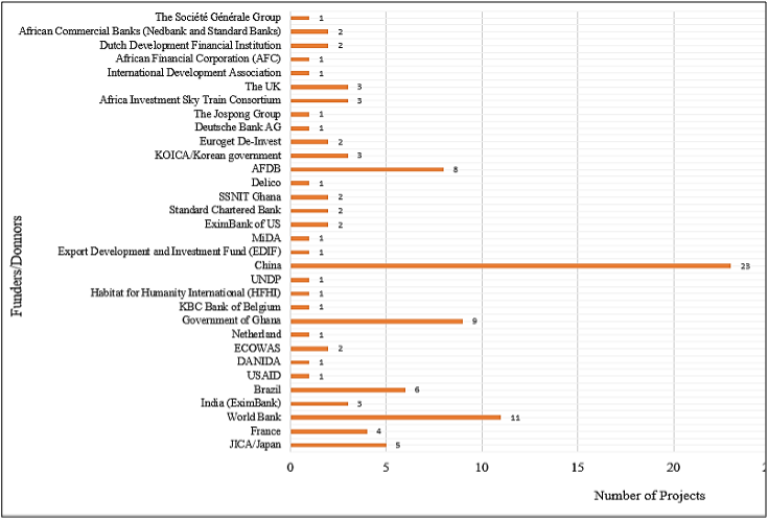
Source: Derived from Daily Graphic and Daily Guide, 2011-2021
The US and the UK, who are considered top trade partners for African countries and are amongst the top donors and investors in Ghana (Tatjana et al., 2021), received less reportage on Accra’s urban infrastructure projects compared to China. While this could reflect that they are investing in sectors other than infrastructure or sectors which were not covered by the two media, it confirms Folashade’s (2016) assertion that China is slowly overtaking the Western superpowers in terms of investments in African countries and Lee’s (2017) argument that China is seeking spatial and political fixes to its over-accumulated crisis amidst Africa’s wish to access loans for projects that do not meet the criteria of potential Western and multilateral agencies. Dittgen (2021) provides more data on the dynamics of these Chinese investments in Africa. But more significantly, many African countries continue to benefit from Chinese-funded large-scale infrastructure projects which boost their economies and kick-start industrialization (Sun et al., 2017). Funding from France, Brazil, Japan’s JICA, and India are also reflected in the media coverage. For instance, the India Exim Bank funded the Tema-Mpakadan Railway project (formerly known as the Tema-Akosombo rail project) and JICA has funded Phases 1&2 of the Tema-Motorway interchange.
Figure 6: Circuits of investment in GAMA’s infrastructure projects
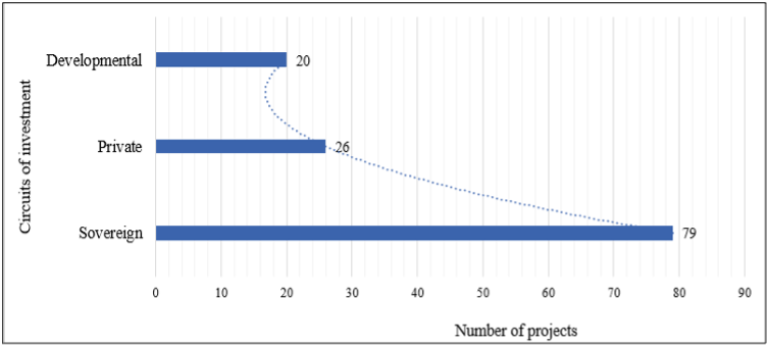
Source: Derived from Daily Graphic and Daily Guide, 2011-2021
As captured in Figure 6, most of the infrastructure projects published by the two media outlets were funded by sovereign states (i.e., central government and government-corporate agencies and/or banks). This means that, out of the total pool of 136 stories that Daily Graphic and Daily Guide published on GAMA, infrastructure projects under the sovereign circuit topped (79 stories). The private circuit, which is an investment from the private sector, was second with 26 stories, and the developmental circuit (i.e., funding from development institutions) received the least amount of media attention (20 stories). This indicates that sovereign funding attracts most media coverage and accounts for the majority of donor investments towards urban infrastructure development in GAMA.
- Conclusion
The analysis revealed that the Daily Graphic reported more on infrastructure development than the Daily Guide. This is because it’s state-owned and may have had more access to first-hand information on projects. These reports were largely on roads and transportation-related projects and some drainage and sanitation issues. The findings also showed that, among the actors driving infrastructure development in GAMA, reports on funding from China dominated. This confirms the prominent role of China in infrastructure development in Ghana and Africa more generally (ISSER, 2020). As also argued by Yu et al. (2020), a good reason for Chinese dominance in the media is that China has a lot to offer Africa in the same way that Africa has a lot to offer China, notably in access to minerals and markets. One concern in the Ghanaian case may be that if these infrastructure investments are not fairly spatially distributed, they could reinforce the privileged position of GAMA over other cities. Notwithstanding these, it is clear that investment by various transnational actors has played an important role in GAMA's development processes and attracted considerable media attention. While these financial flows are crucial to bridging Ghana's urban infrastructure gap, there is an urgent need to consider the implications for urban governance of the continuous presence of transnational actors in key areas of urban development decision making. The Making Africa Urban project is investigating the cases of Tema Port Development, the World Bank funded GARID, and the private West Hills Mall development in order to deepen our understanding of these governance processes. Going forward, the data analysis presented here can be expanded to include electronic media as this also plays an important role in covering critical urban infrastructure projects. Many reports are initially published on the social media handles of the office of the president, vice president, politicians, and other media outlets. Social media responses may help to gauge the relevance of these reports for the public. Additionally, expanding the analysis to cover more urban territories, could help to unravel the range of actors and governance mechanisms shaping processes of urbanisation in African countries.
Reference
Agyei-Mensah, S., Kyere-Gyeabour, E., Mwaura, A., and Mudu, P. (2022). Between policy and risk communication: Coverage of air pollution in Ghanaian newspapers. Int. J. Environ. Res. Public Health, 19, 132–246.
Elloit, R. (2018). Ghana media measurement report: Top tv, radio, and print outlets in 2017. Washington: GeoPoll.
Folashade, S. K. (2016). Passive agents? bureaucratic agency in Africa-China negotiations: A case study of Benin. Working Paper No. 2, Global South Unit, London School of Economics and Political Science.
ISSER (Institute of Statistical, Social and Economic Research) (2020). State of the Ghanaian Economy Report 2020. Accra: University of Ghana.
Kenis, A., and Barratt, B. (2021). The role of the media in staging air pollution: The controversy on extreme air pollution along Oxford Street and other debates on poor air quality in London. Environment and Planning C: Politics and Space, 40, 611–628.
Lee, C. K. (2017). The specter of global China. Politics, labor, and foreign investment in Africa. Chicago: Chicago University Press.
O’Brien, P., O’Neill, P., and Pike, A. (2019). Funding, financing, and governing urban infrastructures. Urban Studies, 56(7), 1291–1303
Owusu, G., and Yankson, P.W.K. (2017). Urbanization in Ghana: Retrospect and prospects. In E. Aryeetey and R. Kanbur (eds.), The Economy of Ghana Sixty Years After Independence, 207–222, Oxford University Press: London.
Sun, I. Y., Jayaram, K., and Kassiri, O. (2017). Dance of the lions and dragons: How are Africa and China engaging, and how will the partnership evolve? New York: McKinsey & Company.
Tatjana, H., Bendix, H., Vito, B., and Skoko, H. (2021). Impacts of investments in infrastructure projects on emerging markets’ growth: The case of East African countries. Economic Research-Ekonomska Istraživanja, 34(1), 2135-2161.
 Close
Close

